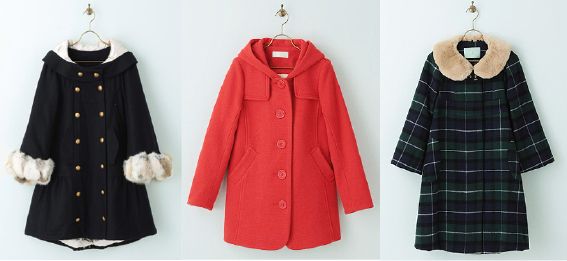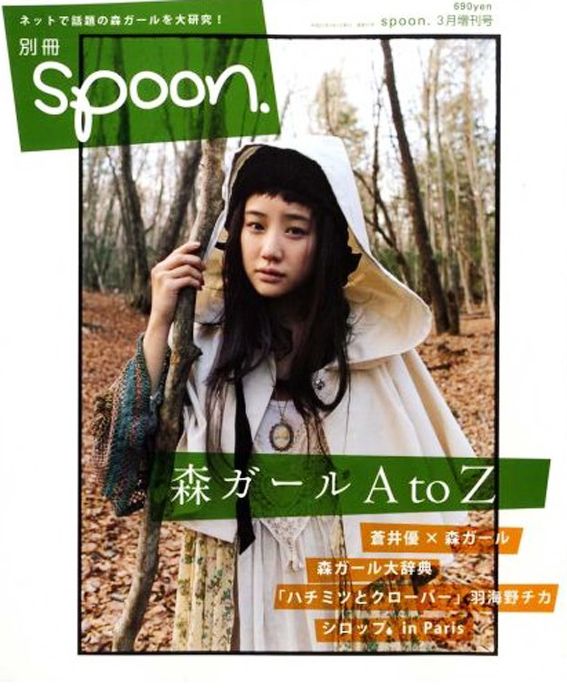The "MORI GIRLS"
A New Japanese Subculture!
Tokyo trend watchers have been hungering for a new subculture ever since the Yamamba last sported an overripe tan in 2004. Finally there is something new and noteworthy. Half a decade later, however, the newest clan to emerge couldn’t be more different from those panda-eyed irreverent teens beloved by street-gawkers and fans of the outrageous. Meet the Mori Girls, a new band of women with a penchant for layers of delicate vintage and DIY fashion. In addition to knitting, journaling, and haunting second hand bookstores, these urban dreamers can be found with their heads in the clouds—or literally in the forest. “Mori” means “forest” in Japanese.
While the Japanese media (and marketers) are fond of giving clever names to new looks, this latest fashion development is self-branded. According to legend, one friend told another that she “looked like she belonged in a forest,” leading to the coining and subsequent cult-age of the “Mori Girls.” Said friend (the one who looked like she came from the woods) founded a community for like-minded women (and men too) on Mixi, Japan’s enormously popular SNS site, in the summer of 2006. While membership to Mixi requires an invitation from an existing member, the communities are self-selecting groups based around a shared interest—with themes that vary from lovers of ketchup to fans of photographing abandoned train stations.
Just shy of three years later, the Mori Girls community is now over 30,000 strong. If the GothLolis have Harajuku, and the aforementioned Yamamba had Shibuya, then these figurative forest dwellers are colonizing an area of cyberspace with profile pages and blogs devoted to their yarui (loose and relaxed) lifestyle. Considering that Mori Girls are, by nature, somewhat loners and prone to solo leisure activities, this online component gives the clan a unique cohesiveness.
So how do you know if you might be one of them? The Mixi community profile page spells out upwards of 60 characteristics of Mori Girldom. Fashion wise, there is an affinity for floaty a-line dresses, an admiration of lace, puff sleeves, and retro prints, a fussiness over natural materials, and a preference for warm, earthy hues and deep traditional colors like navy, wine red, and forest green. Oft-spotted accessories include leather satchels, fur stoles, tights, round-toed shoes, pocket watches, and handmade jewelry.
More than meeting a fashion requirement, however, Mori Girls exude a certain aura of a dreamy slow life. Picture them strolling one of Tokyo’s few remaining bohemian neighborhoods, like Shimokitazawa or Koenji, analog SLR camera in hand. Or scribbling in a leather-bound journal from the corner of a café where none of the teacups match (but are served as a matter of course on saucers). It is likely that a number of them can make macaroons from scratch.
While hardly aggressively counter-culture (appearing instead almost limply indifferent), Mori Girls do posses a certain against-the-grain quality. They make their style choices based on the “atmosphere” of an item, as opposed to its trendiness or brand name value. Consequently they shun conventional fashion magazines and mass-produced items in favor of handmade, original pieces. Quirkiness is important. Age is not. There is nothing in the creed that singles out youth or a particular generational experience. And unlike teenage fashion cults like the Shibuya gyaru (who see many members “graduate”), there is nothing about being a Mori Girl that rebels against growing up. / By Rebecca Milner
![[date-header-bg.gif]](https://blogger.googleusercontent.com/img/b/R29vZ2xl/AVvXsEiCYE3aiPBDWXi-w43FiVfcz7g1sWfQbZekRtSRUquWmWhw6Meh7CwiOGZ_rw2xTPWrmXx1hs9Xdb1po-nZeRoxKqVO1r2IGQRwZqVs3r6Xo7OZP77jnFHpZNSW9kWkvY6Eh_ugorJDgOKe/s1600/date-header-bg.gif)
Sally Scott
![[Sally+Scott+6.png]](https://blogger.googleusercontent.com/img/b/R29vZ2xl/AVvXsEjVpMSXTuOmn0BaMBJcdioYOtUTLBKeTvAaFl5C2Bl1idiLtNRDhTswuA-gxndnpxwjnsGphGzJnF6THv6QZOD3rG17McG3IQ3CuBKu8XmmKA5pIs7xp8CDjHTzRk-UiYYWp0Bc5YKnAWU/s1600/Sally+Scott+6.png)
Part of the charm of the mori girl lifestyle is that it offers a quiet brand of escapism. And there are few things more appealing to would-be escape artists than an imaginary life. Akira Minagawa's fashion label Sally Scott offers just that.
Sally Scott's brand concept revolves around the life of the imaginary girl (lives in Ohio, no dogs, two cats) after whom the brand is named. Of course, this means the label's catalogue is filled with charming images of a quiet little life many mori girls would aspire to.
Sally Scott's brand concept revolves around the life of the imaginary girl (lives in Ohio, no dogs, two cats) after whom the brand is named. Of course, this means the label's catalogue is filled with charming images of a quiet little life many mori girls would aspire to.
![[Sally+Scott+8.png]](https://blogger.googleusercontent.com/img/b/R29vZ2xl/AVvXsEgb1Z7LgWCfNKJ9Vho4k_ofmMImBwJtLhwtF-qj4AmHNQ4FAzMOBUppfbayr7CxR0IJnZMN6cYAAFEywSkASnKaI5BQ-zQKLRYOognLjMDKk7Mb4WWyMhd2tjUV4ST-qYvrsbxK-a5TmyA/s1600/Sally+Scott+8.png)
Of course, Sally Scott would have to be immersed in a vintage-inspired environment careful not to be too cloying and sweet but cosy nonetheless.
![[Sally+Scott+7.png]](https://blogger.googleusercontent.com/img/b/R29vZ2xl/AVvXsEhavtbSScHWNGhFM9-K9dedIr1twzBTo-tin5EXM2Ipp68k8k5zIw3rmkcBN2tDGVXO4C8eCENoj8S1LuT0NJv_gYAjRF5RznCeDmiFTVyu_ykQhz-uSqdiMGCdI85aypSnoyxwW92ZrKM/s1600/Sally+Scott+7.png)
![[Sally+Scott+9.png]](https://blogger.googleusercontent.com/img/b/R29vZ2xl/AVvXsEgR6CQ_Sv0NXJMHFqy7kkv96V_LrbjMiMlqEMwJGbC-UlvvhW2O_KiIztInCEkKCrlwSQXiZ2S8cJsxw1QRT0-Le9eBJLl23rbX4tO9RiGIy7L3EdNHJKFHS1cP_DACua8GHFYRCA98-IQ/s1600/Sally+Scott+9.png)
She is frequently seen around rabbits and cats that possess strangely human qualities.
![[Sally+Scott+5.png]](https://blogger.googleusercontent.com/img/b/R29vZ2xl/AVvXsEhwTVyherA-r8V8XkLUQh7uRlM2iEPKCnNG71m8Pwirt0ltryecPgiv_lmXK_tqwc4QgzrqRmGHXB_3a7CQ7UzziJ1aoq1BQhnD5udI9qF5kffrDLoXw3m_pFlNIt9mpGBf-0LHQZVxxvY/s1600/Sally+Scott+5.png)
![[Sally+Scott+14.png]](https://blogger.googleusercontent.com/img/b/R29vZ2xl/AVvXsEiBKK9zram-yQztRcaMHrLBAL4pTbibihHxe_J8wn2A-gvEgcTGfu7fFAqleFmJUXjKUtkFD_QtMFuty7cMdV84JZgSZbf1J9akkvm8flV0ac0U0HfVvPE9UoIEIL3_Xe6excD0UH7IT9w/s1600/Sally+Scott+14.png)
Needless to say, Sally Scott participates in all manner of quaint recreational activity, from blowing bubbles to bicycling.
![[Sally+Scott+12.png]](https://blogger.googleusercontent.com/img/b/R29vZ2xl/AVvXsEhEHd5Zj_1nSTAdcz4963_gPRiFUHjHMbmG4boD_9-oPmO_XoI6vNJ178d56GpV1ZRwxs8-ObSN4e1OVTjeqyUQvaRH5C3DfuJRvkZvEZT8x6nYzQIMFa61VV3cRuwt4e-BGGLcbRnh8RQ/s1600/Sally+Scott+12.png)
![[Sally+Scott+13.png]](https://blogger.googleusercontent.com/img/b/R29vZ2xl/AVvXsEhwZFWw_ywzNT4ksEgoSz_9akjsTUtLokvpgidRet_U8nOqiQcCCfkcilDViQluS5JOxTXRy7MBseIc0PfEX3C3rbJnjgh6HBJiKIx35U6hcVuQv1c6NrhJZZh8BfqNi1vyRB4vhac9pMQ/s1600/Sally+Scott+13.png)
And as any full-fledged mori girl would tell you, life imaginary or otherwise would not be complete without a few long walks through some foliage.
![[Sally+Scott+10.png]](https://blogger.googleusercontent.com/img/b/R29vZ2xl/AVvXsEgIJjGCH0PmqyshQVVgh6_wvPn54W6OpF7p6ou1f6SvEKbk_MlEfp1PeeXvFrWA8qfAyrzRw2nBnozMobG3vhZcMW1uTJZ8JGPvGjOwTSQUVKZ1HZFPUTK9217lxslJysZZUGs4h8ba6rU/s1600/Sally+Scott+10.png)
![[Sally+Scott+11.png]](https://blogger.googleusercontent.com/img/b/R29vZ2xl/AVvXsEgJpCLHT8j0hA-psKBfF2BbpqvzDh_h9m6ymD7kBBYZwdoXFmluUUn37RzJpd4njW79JN2AHOgvOIAA4dtVbzLncKVQsjNkKANKK7Trx0KqYTw-VLb6DiU2ntgfQyuyUG57rLcm6CHSsRQ/s1600/Sally+Scott+11.png)
Sally Scott manages to do all this all the while clad in sixties-inspired frocks, pretty printed skirts and cute collared blouses.
![[Sally+Scott.png]](https://blogger.googleusercontent.com/img/b/R29vZ2xl/AVvXsEjAUuhT4UlRr1CzJAeGX_Gcb-ARHVvfDxB9vSmLwGJptN2J_AcnTWpeJr5s1COw2MRUKs5Y0G_HvXNGrCWiZz2uRblX9FcsQaGFWH07n_rGGajysEFB_-4su_BSUW8H8X6XQ7cMVOZAkl8/s1600/Sally+Scott.png)
![[Sally+Scott+2.png]](https://blogger.googleusercontent.com/img/b/R29vZ2xl/AVvXsEirgdO9cu8jJNY5jb1OGO0D-NPP-kS1EGnwlTSP7mSDhe1j6g2q6g1GsxJuUwTr86aB9JwuYjufZ5uqvgsaESMazYuDmue6-rixfzdJz8HpVZkEIlP4Mz3it3watYSHZ6CZV9u-aqRwn9U/s1600/Sally+Scott+2.png)
![[Sally+Scott+3.png]](https://blogger.googleusercontent.com/img/b/R29vZ2xl/AVvXsEibzx3M8-W_biszbVU5PZQ40XvNMkv9zS80ySMHrqObEa7QuGDc2Z7niBAJuG91Xlo52BAEtSWRFzKJ_vB9j2-2G_dbPdYvzNbOmM1CyFXHfeDN6pGB3iyZdnmCqRc_RzoIh5IAsGT2wsw/s1600/Sally+Scott+3.png)
![[Sally+Scott+4.png]](https://blogger.googleusercontent.com/img/b/R29vZ2xl/AVvXsEghiB2Yy5Kj_1yZ14TyAsntj72JkZnBQBAWxRud1kwFgc0m8y3Pw5IBlNU0gqJLOW2xi-J2V_9ATLAe7XdH1Xzg3_j1QnyMNlGLLSgcPCE6L5GLg7Qhx_89qN6jy5JUjrYYbAm6MdOHrPk/s1600/Sally+Scott+4.png)
![[date-header-bg.gif]](https://blogger.googleusercontent.com/img/b/R29vZ2xl/AVvXsEiCYE3aiPBDWXi-w43FiVfcz7g1sWfQbZekRtSRUquWmWhw6Meh7CwiOGZ_rw2xTPWrmXx1hs9Xdb1po-nZeRoxKqVO1r2IGQRwZqVs3r6Xo7OZP77jnFHpZNSW9kWkvY6Eh_ugorJDgOKe/s1600/date-header-bg.gif)
Syrup Spring 2010
Catalogue
The Syrup catalogue is consistently and unfailingly enchanting. Their beautiful pictures always inspire me to live a slightly sweeter life. The three concepts shaping the Syrup Spring 2010 collection are not only charming but also strike a chord in the hearts of mori girls. I have no doubt that the clothes are but a fraction of Syrup's charm.
The first concept, 'Syrup Culture Club,' brings to mind a quiet lifestyle filled with piles of books eagerly waiting to be read, old movies and solo voyages.
The first concept, 'Syrup Culture Club,' brings to mind a quiet lifestyle filled with piles of books eagerly waiting to be read, old movies and solo voyages.
![[Syrup+Felissimo+Spring+2010+15.png]](https://blogger.googleusercontent.com/img/b/R29vZ2xl/AVvXsEjqBhA7dcPx4mPjbDbQACqA8jhekcMQU9lduXuqqYOvOExIKrPKDd7xQTlgEN-u8TXK5XSVob1exASaL6uKQhmkyhrJ6GEXxTBfoha0rUAYshKy3eC2okOg9jzeVq5Ac1K_8d6q7ysR0y0/s1600/Syrup+Felissimo+Spring+2010+15.png)
![[Syrup+Felissimo+Spring+2010+4.png]](https://blogger.googleusercontent.com/img/b/R29vZ2xl/AVvXsEiDwP-0-E9ONNy8ySNfA4WTCId-Z49KprlmI8dSWdNYJm0NSJxECUs0DZqMg4JqckyyW8tpTwKlqNEN3d-ohgkdzFSOB6fyysAD5bez64GC_-jP9kyvrvnjWLLTvAAwYOzzDuY8ib0_gn0/s1600/Syrup+Felissimo+Spring+2010+4.png)
![[Syrup+Felissimo+Spring+2010+1.png]](https://blogger.googleusercontent.com/img/b/R29vZ2xl/AVvXsEj4OVFq4RPnxOx_J6-pX24xCnuvbkv0ErIJCLzOKe1K43Zoc0Eq_bW96rRuHfErd5uyWisbP6nRv2QHSTUeAdhw-auZGXQuF4BFeHI4khj5TjRMElEfT-NxlEA_GQlN9yZvNcUJuJ00-K8/s1600/Syrup+Felissimo+Spring+2010+1.png)
![[Syrup+Felissimo+Spring+2010+16.png]](https://blogger.googleusercontent.com/img/b/R29vZ2xl/AVvXsEipUeuUgdRm3jiwWHMGQTyM0UWmSAjeauuEOCSxdqc6dNbFNeUUFok7a_QAPRc40CPYaXVyQj4yQnV67E2G99VnQjbcGJ9Y3VLXxjo4bQ6I15j8Mfe0sasHu2itk3qZKr6CqM8Tlre-UM4/s1600/Syrup+Felissimo+Spring+2010+16.png)
![[Syrup+Felissimo+Spring+2010+2.png]](https://blogger.googleusercontent.com/img/b/R29vZ2xl/AVvXsEid59z5SjeqkzNtySFXilUHM-4PbEUS16TvmiMJbHIpDKLoxqH4gIRrmzpXesJ1lCMN2IsvoW8KtgyrqUiShwRXMfgf3jYCxmAVhy7OOt55Rd4Di5y3NxBHBEcoRO9EAr2KDNZMzx-lAbI/s1600/Syrup+Felissimo+Spring+2010+2.png)
![[Syrup+Felissimo+Spring+2010+3.png]](https://blogger.googleusercontent.com/img/b/R29vZ2xl/AVvXsEhGosEwKpWwqRHusExUm6nn0JrhAloT_Bm6KIaYr_DPaNBtBIMFiSErgqoAOGnd8pCaa5iBm7saiKdBPRDrMpJahJHeZKZXF6lkGJ77EV1LXRN7E-lj8-w57Un29n2Ipyn68CtVUqg9aac/s1600/Syrup+Felissimo+Spring+2010+3.png)
The clothes this time around are a bit more urban than those in their previous collections. The brown loose cuffed trousers and the khaki coat (in the first picture) remind of adventurer Tintin. Skirts are paired with loose tops, and the long-sleeved worn under the one-piece dress makes yet another appearance.
The second theme is a picnic at the botanic gardens. Personally, I love picnics, and I'm certain many mori girls share these sentiments. They're a great, hassle free way to feel a little closer to nature, even when you live in the city.
![[Syrup+Felissimo+Spring+2010+5.png]](https://blogger.googleusercontent.com/img/b/R29vZ2xl/AVvXsEg46r8kWOuhL4WjMqHRltbY1NMV0pC6A0ZTb0aUooUWOVAMXVYiy3SnAeKZgCnkZ-LdzspSRDKYDKgquEsnS4Mp3Z9juSpj7BvqarVhSbQnf9OJ48ZCY1kiwWFLA8qgEEvOlJMaGTFec1Y/s1600/Syrup+Felissimo+Spring+2010+5.png)
![[Syrup+Felissimo+Spring+2010+6.png]](https://blogger.googleusercontent.com/img/b/R29vZ2xl/AVvXsEiqX98M78dSHiI8Iu0HM7jPfv-r4rpv3u_44WM8RJ2pdUYjp1t5iclr5ANmPR8mAHUPUJDIt_pebU-6vPG7rWIfrVt11bwhgzp9Ou3PWzw9M9VoIPyjiv6OY3EK5rBwrZz5MbjesIxVMpU/s1600/Syrup+Felissimo+Spring+2010+6.png)
![[Syrup+Felissimo+Spring+2010+7.png]](https://blogger.googleusercontent.com/img/b/R29vZ2xl/AVvXsEiXRlnias8w3Gzzs_WwauMuosdGGX0aLRs8rdIGKL4c8thKgcfU2zus2OKqmoiYUx9Vgqng1BujJfZaEZZRP2eCjttILBnc9You-5ijbIdAkS_WdFFRYP0xHX_g-2sTxAOUG6fKeyt10wM/s1600/Syrup+Felissimo+Spring+2010+7.png)
![[Syrup+Felissimo+Spring+2010+8.png]](https://blogger.googleusercontent.com/img/b/R29vZ2xl/AVvXsEh0Pd5TBa7Sp-Vo-ledVp2XCgT6l0Eo8FJbzPvG4x-o5aCd4nUbdZh9Z_G0ffBkN1b1h89tcAuUtOHECUeAtslMXJYpLY2kfkXb2S1_XWG-vpfG333Td3K50IJ6zEz8Q2Z5Y_ENB5TkGFY/s1600/Syrup+Felissimo+Spring+2010+8.png)
![[Syrup+Felissimo+Spring+2010+9.png]](https://blogger.googleusercontent.com/img/b/R29vZ2xl/AVvXsEgA1BIfedYMQW437EsluZex-JN7Z-yOhqDivZ3-daSKdIdUHsjojt-6zUwLeG9AsCWhwCtnwb2CyCeXklexUWawDg9gnm1npl8sICEKiuoFIy79A7TRjJmvTk2mMjK5cRbzhqc9DmbJdGk/s1600/Syrup+Felissimo+Spring+2010+9.png)
![[Syrup+Felissimo+Spring+2010+10.png]](https://blogger.googleusercontent.com/img/b/R29vZ2xl/AVvXsEivdc1JbQk4Ce8rlVPRbz2fZrPhWQIgT6R5qkrNAaof1dssptzFEExQtl6GlaW4s2USbw2sn97n1x_ovPQl7FIzU9iw80ESiummKzfVY8fHvA2rBR7Z-T0yGfynm7rdrJwRfQoT-eyqVrg/s1600/Syrup+Felissimo+Spring+2010+10.png)
I love the different picnic set-ups in each picture. A-line dresses are featured liberally in this photoshoot and offer a comfortable way to enjoy picnics in comfort.
The third concept features lots and lots of flowers, primarily indoors and in pretty vases. The models are pictured in such beautiful surroundings. Anybody coming home to a house like that everyday would be lucky indeed!
The third concept features lots and lots of flowers, primarily indoors and in pretty vases. The models are pictured in such beautiful surroundings. Anybody coming home to a house like that everyday would be lucky indeed!
![[Syrup+Felissimo+Spring+2010+11.png]](https://blogger.googleusercontent.com/img/b/R29vZ2xl/AVvXsEjtBsorConHzJ2TbmOeEdV1aJ09HKdv84LyZRR7azxTT7UX-Sr2Gghe8yx0KuQySovIMlHbNmDNp9esnFcH8EAkQWzYLx_szMgoUl-Jv4Mz32Lqmmx8dHVzzHfwOw45ZZhD_VduFaLSHpQ/s1600/Syrup+Felissimo+Spring+2010+11.png)
![[Syrup+Felissimo+Spring+2010+12.png]](https://blogger.googleusercontent.com/img/b/R29vZ2xl/AVvXsEgVg8GGK-5RjNGbZPiJ6-kOEV7AAqUyFIJ1VwLXH-7NthDHoMnKRD6ApijrpA7TKM1D6GuvpXtKLS418H0UyKceEQVVEkRULmaorM03a8E1aNPgqqzJgrSBdgIdw9mIhCAHwER5nGze0IA/s1600/Syrup+Felissimo+Spring+2010+12.png)
![[Syrup+Felissimo+Spring+2010+13.png]](https://blogger.googleusercontent.com/img/b/R29vZ2xl/AVvXsEgbGj7JndMGssj5tEaQeL7o30jk-3RwBBuFbH_X6MJoXD1O-MnLagBg_i-DlN7SDEO6ZRRuRkwnNpzf58Ta4iQoFD-lhAcM6auL3hxO92RN6EH9PB8lOWadh0k8VgdJDfYH3sTiujY7Ja4/s1600/Syrup+Felissimo+Spring+2010+13.png)
![[Syrup+Felissimo+Spring+2010+14.png]](https://blogger.googleusercontent.com/img/b/R29vZ2xl/AVvXsEjxhipI2KCojqS6y7ROjnNSH6QVGAUhhdbwznPR8t6rHUKJS3gxUwzOvbDBmaUvsexMwl1HZFgMPKFYrIcIR6gaofOrbn6xYcIIqTEhyphenhyphenFTzeCLO1Ra2AutfPriWkam7g1sxPlohFQPn5hU/s1600/Syrup+Felissimo+Spring+2010+14.png)
The first dress has a lovely, elongated silhouette that's made a little cuter with white sneakers and apatterned top. The models always look so contemplative that just looking at these pictures calms one down right away.
Image source: Felissimo
![[date-header-bg.gif]](https://blogger.googleusercontent.com/img/b/R29vZ2xl/AVvXsEiCYE3aiPBDWXi-w43FiVfcz7g1sWfQbZekRtSRUquWmWhw6Meh7CwiOGZ_rw2xTPWrmXx1hs9Xdb1po-nZeRoxKqVO1r2IGQRwZqVs3r6Xo7OZP77jnFHpZNSW9kWkvY6Eh_ugorJDgOKe/s1600/date-header-bg.gif)
Mori (Forest) Girls


I would love to be a Mori Girl.

Have you heard of Mori Girls?
Here is a little description from Mori Girls blog:
The mori girls (森ガール) belong to a subculture which began in Japan. 'Mori' means forest in Japanese, and if you're looking for the simplest description of mori girls, they are girls who look like they live in the forest. Indeed, the unique appearance of the mori girls is what attracts most people to join in their adventures.
Mori girls are often seen in loose dresses or smocks, vintage blouses, puffed sleeves, A-line skirts tights and leggings and many-layered ensembles. They delight in beautiful fabrics and textures, preferring natural to synthetic materials, and are impartial to autumnal shades reminiscent of forest glades such as deep reds, greens, blues and browns. They keep warm with knits and furs in winter, and ponchos and leather boleros in the fall.
The childlike nature of mori girls sets them apart from the more aggressive and carnivorous women in the city. They shun stiletto heels for flat shoes and prefer to keep their fingernails short and skin fair. Mori girls are also drawn to animal, candy, checked, floral, vintage or polka-dotted prints. However, they avoid looking overly cute. They wear little makeup, but when they do use it some like to draw pick circles in the centre of their cheeks as a homage to the dolls they played with when they were younger. While every mori girl is a child at heart, they are endlessly fascinated by objects with a history. Vintage items such as pocket watches, small gold pendants and analogue cameras captivate mori girls.
Mori girls are also characterised by certain attitudes to life. While most mori girls really live in the city, they maintain a pace of life that may be considered slow by others, preferring to stop and savour the tiny delights that many deem insignificant. Mori girls like to explore old neighbourhoods, discover hole-in-the-wall shops and read in cafes. Many mori girls enjoy expressing their creativity, never mind if nobody will see or applaud their efforts, for instance through photography or journalling. Scandinavia is for many mori girls a dream destination, and Scandinavian design influences often appear in mori girls' style.
In her own quiet way, the mori girl is an individualist. She does not care that the world may live differently from her. She lives consciously and chooses her own lifestyle. The mori girl often looks whimsical or quirky. When she shops, she buys something based on how it makes her feel, rather than on how fashionable or expensive it will appear to others. While she may enjoy the company of others, the mori girl loves her own company and indeed has embarked on many of her most memorable adventures alone.
How lovely! And the best news is these Mori Girls don't shy away from a bit of Mori-girl-meets-1960's-retro style action! Which suits me just perfectly!
Oh, and I am desperately wanting one of these winter coats (above) from Japanese store Franche Lippee seen on Mori Girls Blog. They would be just perfect for my Tokyo holiday next week.
You can find out more about the Mori Girls here.
![[date-header-bg.gif]](https://blogger.googleusercontent.com/img/b/R29vZ2xl/AVvXsEiCYE3aiPBDWXi-w43FiVfcz7g1sWfQbZekRtSRUquWmWhw6Meh7CwiOGZ_rw2xTPWrmXx1hs9Xdb1po-nZeRoxKqVO1r2IGQRwZqVs3r6Xo7OZP77jnFHpZNSW9kWkvY6Eh_ugorJDgOKe/s1600/date-header-bg.gif)
“When you called these girls 'Muji Girls' as we would spot them chilling in the Muji Cafe in flats and tent dresses. I love them! they always had super cute muji boyfs as well!”
Special Thanks to post and researcher to fashionsnoops, morigirl, hellosandwich
.........................................................................................
"atmosphere"
Age is not, there is nothing
about being a Mori Girls
that rebels against
growing up.
Items in favor of handmade,
original pieces!
about being a Mori Girls
that rebels against
growing up.
Items in favor of handmade,
original pieces!
the portastylistic







No comments:
Post a Comment